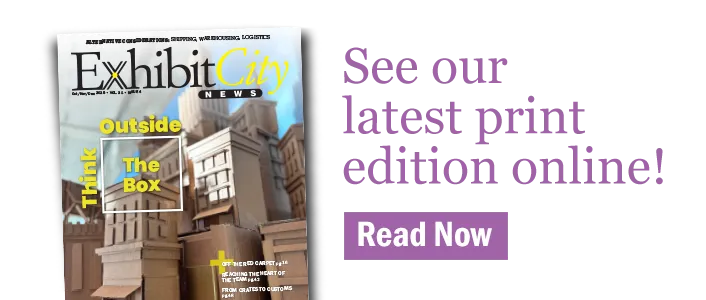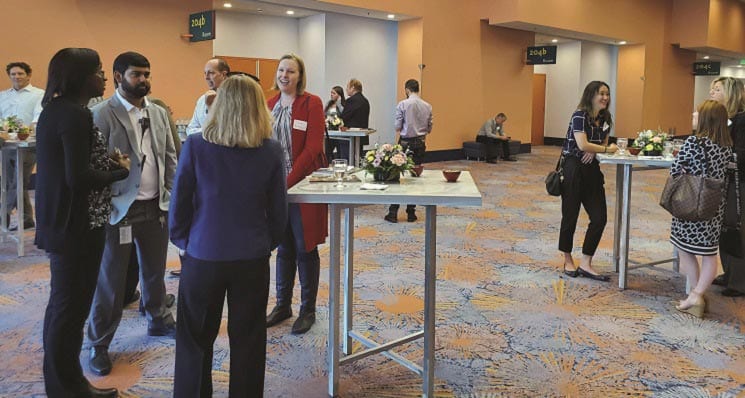“Situational Awareness” is Key to Deterrence
by Leslie Mujica & Jeanne Brei
Sponsored by EDPA, ESCA, EACA, IAVM and IAEE’s Chapter Educational Grant, the Anaheim Convention Center was the site for a fall education session on show venue security. Held last Oct. 23, nearly 100 industry folks attended the luncheon as others listened to a live Facebook feed of the event.
ESCA Executive Director Larry Arnaudet began by sharing information and a presentation regarding the Worker Identification System (WIS) badge program. Currently, the program is operating at 20 venues and has issued more than 40,000 badges nationwide with two more venues being added in January. WIS operates with no cost to the venue and minimum cost to the contractor that wants to register their workers, Arnaudet said, explaining that ESCA identified the need to create a vetting/credentialing system that didn’t rely on labor having “to find out what the magic handshake is” in order to enter a venue to do their job. When scanning technology is used, the badges create a log and timestamp of when the workers gain access to the building upon entry and exit.
 Featured speaker Mark Herrera (pictured left), a seasoned law enforcement officer and trainer of 20 years with the Hobbs, N.M., police department, was up next. Herrera is currently the director of education for the International Association of Venue Managers and teaches Situational Awareness-Mindset training. He also represents the Department of Homeland Security Office of Infrastructure Protection through the Public Assembly Facility Sub-Sector Council.
Featured speaker Mark Herrera (pictured left), a seasoned law enforcement officer and trainer of 20 years with the Hobbs, N.M., police department, was up next. Herrera is currently the director of education for the International Association of Venue Managers and teaches Situational Awareness-Mindset training. He also represents the Department of Homeland Security Office of Infrastructure Protection through the Public Assembly Facility Sub-Sector Council.
Herrera emphasized the importance of increasing observational capabilities by understanding behavioral indicators and patterns that are not appropriate. He believes that the industry focuses primarily on traditional security measures but underestimates the importance of “situational awareness.” Through his training, once observations are made regarding suspicious or unusual behavior, risk mitigation is made through guest service interjection. He believes this approach is a win-win even if the observations are incorrect. He highly recommends a “guest service approach,” which is meant to deter and diffuse potential hostile situations and requires training and a skill set that goes beyond what most are training on today.
He asked the audience, “Can you detect a threat and are you prepared to prevent it?” explaining that it starts with programing our minds and observational capabilities to learn how to spot an individual who has “checked out” or an unusual device that has been left unattended.
He believes that lack of awareness is a major issue and showed a video taken on the Las Vegas Strip where people just walked by an unattended black bag and didn’t do anything. The filming of the video occurred after the Harvest 91/1 October massacre and he talked about how he will go into businesses and people will be oblivious to an unattended bag but will refuse to enter a room with an unattended bag immediately after a local shooting. But then, weeks or months later, they return to being oblivious to the unattended bag. He talked to two women in the video and asked them if they saw the bag and both women said that bag wasn’t there. He then showed them the video of them walking by the bag and they couldn’t believe it and pointed fingers at each other for not doing anything.
Herrera said that in order to respond quickly and control a threatening situation one must disrupt the suspicious individual’s ability to quickly make a decision. By doing what he calls a “loop re-set,” perpetrators can’t orientate themselves quick enough to continue with their intended action, which then thwarts their plans. He emphasized how important it is to not be oblivious to one’s surroundings and recommends that everyone begin mental preparation with “actionable response objectives in advance” in order to have a personal plan of action for any situation. “We must remove hesitation and complacency from our lives,” Herrera said. “This prevents us from reacting to a perceived or actual threatening situation.”
This story originally appeared in the January/February issue of Exhibit City News, p. 70. For original layout, visit https://issuu.com/exhibitcitynews/docs/exhibitcitynews_janfeb_2020























